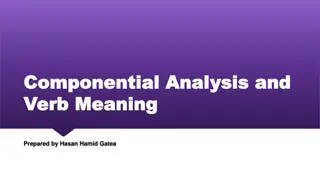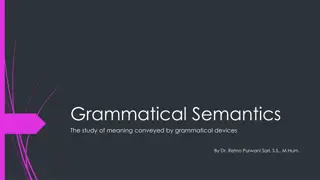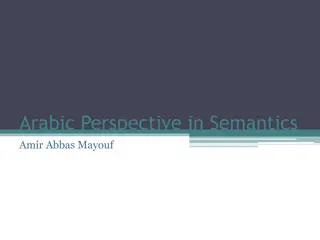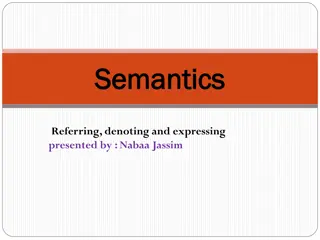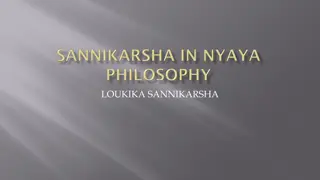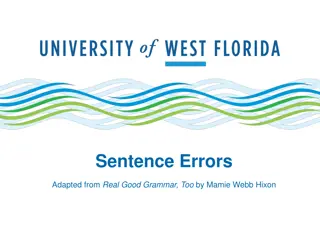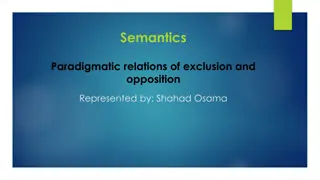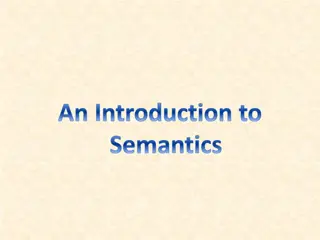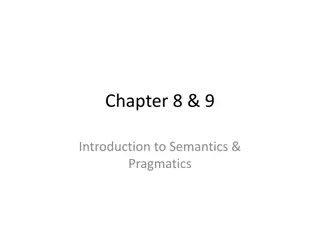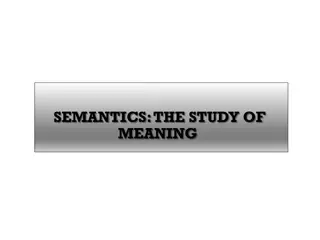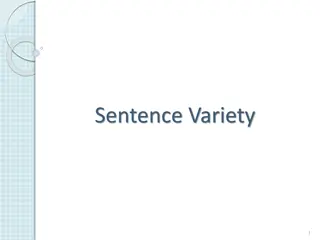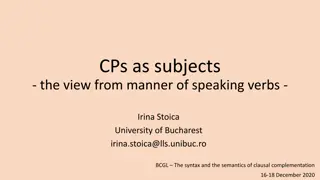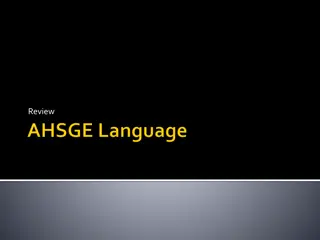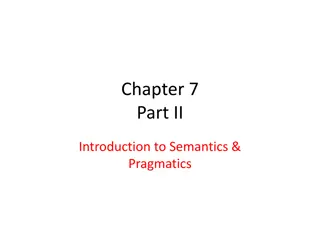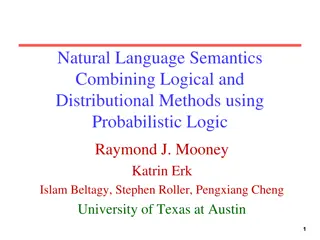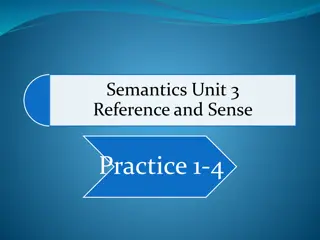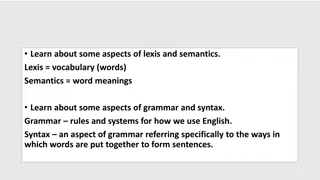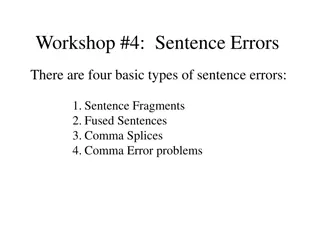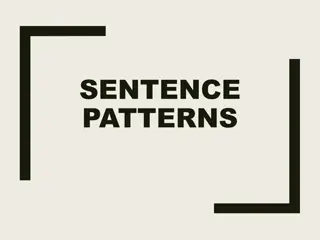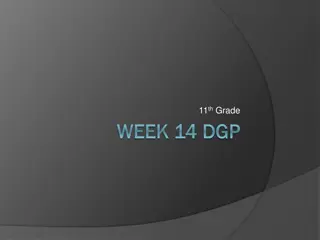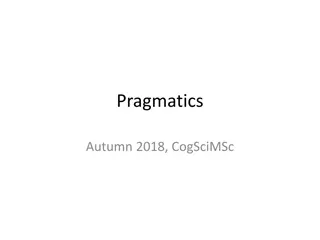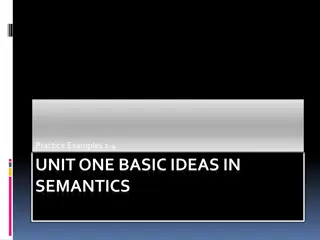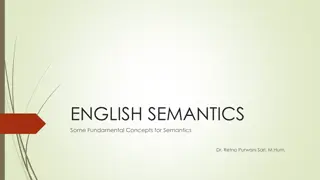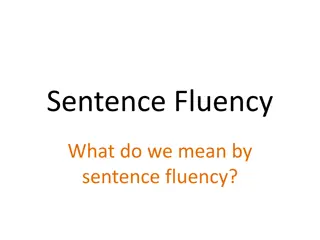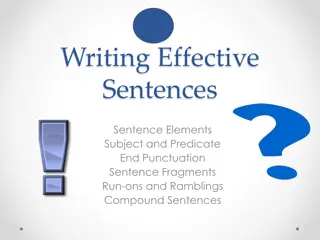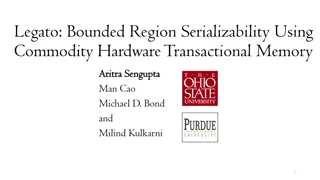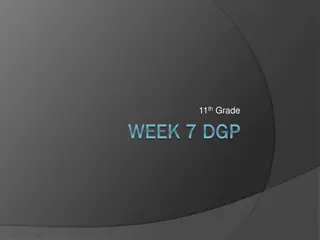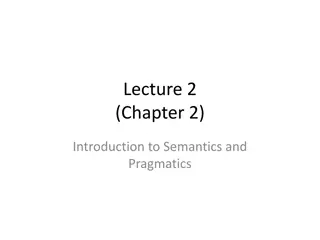Coverage Semantics for Dependent Pattern Matching
Delve into the world of dependent pattern matching with a focus on coverage semantics. Dive deep into the concepts of denotational semantics, topologies, and coverages. Explore the interplay between patterns, values, and types in a novel way, shedding light on the essence of pattern matching.
4 views • 26 slides
Understanding Componential Analysis in Semantics
Componential analysis is a significant theory that emerged in the 20th century to analyze words based on semantic features. It helps identify word meanings by examining components and their features. This method involves representing features as either positive (+), negative (-), or unspecified (.).
0 views • 22 slides
Understanding Predicators and Predicates in Sentence Semantics
Exploring the semantics of sentences, this content delves into the structure of declarative sentences in terms of predicators and arguments. It discusses various classes of items that can function as the predicator of a sentence, such as lexical verbs, the copulative verb "be" in equative sentences,
1 views • 39 slides
Understanding Grammatical Semantics in Linguistics
Grammatical semantics is the study of meaning conveyed by grammatical devices, exploring the semantics of syntax and morphology. By analyzing sentences about a mouse in the countryside, propositions are identified through a four-step analysis, revealing how meaning is constructed through linguistic
0 views • 17 slides
Exploring Arabic Semantics in Linguistics by Amir Abbas Mayouf
The article delves into the Arabic perspective in semantics as studied by linguists like Amir Abbas Mayouf. It discusses the definition of semantics, the difference between semantics and meaning, and the role of semantics in language sciences. The linguistic context, lexical reference, and phonetic
2 views • 15 slides
Exploring Knowledge Base Construction and Commonsense Knowledge in Fiction
Delve into innovative research interests focusing on knowledge base construction using fictional texts as archetypes, taxonomies for constructing knowledge bases, and extraction of commonsense knowledge from diverse sources. Challenges such as sparsity and semantics are addressed through comprehensi
3 views • 48 slides
Understanding Semantics: The Study of Meaning in Linguistics
Semantics is the scientific study of meaning in language, delving into questions about definitions, ideas, objects, relations between meanings, and how meanings interact with syntactic rules. Exploring the vagueness of the term "meaning," semanticists explore sense, reference, denotation, and connot
2 views • 19 slides
Understanding Semantics: Exploring Linguistic Meaning and Expression
Exploring the realm of semantics, this content delves into how language is used to refer, denote, and express concepts in the world. It discusses the importance of linguistic meaning, different approaches to studying it, and the distinction between denotational and cognitive semantics. By examining
0 views • 7 slides
Understanding Relationships in Logic and Semantics
This content explores various concepts in logic and semantics such as Loukika Sannikarsha, Sangyog Sangyukta Samavaya, and more. It delves into the intricacies of relationships and distinctions between different elements in these fields.
2 views • 5 slides
Mastering Sentence Structure and Punctuation
Delve into the intricate world of sentence structure techniques and punctuation usage through engaging visuals and mnemonic devices. Learn how to identify and apply various sentence types, commands, questions, and minor sentences. Discover the impact of different punctuation marks on conveying attit
0 views • 15 slides
Understanding Sentence Structure: Clarity and Completeness
Learn the essentials of sentence structure, including the components that make up a complete sentence, the difference between sentences and fragments, and how to revise fragments for coherence. Delve into the impact of sentence length on conveying ideas effectively.
1 views • 16 slides
Understanding Semantics and Pragmatics in Language Study
Semantics and pragmatics are key areas of language study that focus on the meanings of words, phrases, and sentences. Semantics delves into the literal meanings and language as a system, while pragmatics explores how speakers use language in context. Understanding semantic meaning involves consideri
3 views • 77 slides
An Exploration of Linguistic Meaning: Semantics and Pragmatics
Delve into the realm of linguistic meaning through the lenses of semantics and pragmatics. Explore how words and phrases carry literal meanings, while language usage in social contexts creates both literal and nonliteral meanings. Uncover the intricate interplay between semantics, concerned with the
6 views • 70 slides
Semantics and Paradigmatic Relations of Exclusion and Opposition
The presentation explores the concepts of incompatibility, co-taxonymy, and opposition in semantics. It delves into how certain terms exclude others within a set and the various forms of opposition such as complementaries and antonymy. Examples like "Women, Queen, Mother, Servant, Teacher" illustrat
0 views • 21 slides
Understanding Formal Semantics of Programming Languages: From Lambda Calculus to Separation Logic
Explore the foundational concepts of formal semantics in programming languages, covering Lambda Calculus, Untyped and Simply-typed languages, Imperative languages, Operational and Hoare logics, as well as Separation logic. Delve into syntax, reduction rules, typing rules, and operational semantics i
7 views • 14 slides
Understanding Semantics: The Study of Meaning in Language
Semantics is the branch of linguistics focusing on meaning, exploring how words, sentences, and symbols convey and represent ideas. It is crucial for language acquisition, change, social contexts, and linguistic analysis. Important aspects include symbol and referent relationships, denotation, conno
0 views • 19 slides
Understanding Semantic Properties in Lexical Semantics
Explore the concept of semantic properties in lexical semantics through examples involving word meanings and relationships. Learn how semantic properties form the basic building blocks of language construction, sharing common attributes among words while also showing contrastive distinctions. Dive i
0 views • 17 slides
Understanding Semantic Relations in Language
In semantics and pragmatics, sense relations are categorized into paradigmatic, syntagmatic, and derivational axes. Paradigmatic relations involve semantic choices within a sentence structure, while syntagmatic relations connect items within the same sentence. Examples include synonymy, hyponymy, me
0 views • 33 slides
Exploring Semantics: The Study of Meaning
Semantics is a branch of linguistics that delves into the study of meaning in language. It involves understanding how words and constructions combine to convey semantic acceptability. Linguists explore lexical and sentence meanings, semantic fields, synonyms, opposites, and more to decipher linguist
0 views • 21 slides
Understanding Sentence Variety in Writing
Students and teachers often struggle with sentence variety in writing, which can impact the overall quality. Variety in sentence length, type, structure, and positioning of words helps avoid monotony and enhances the effectiveness of conveying different ideas. Through examples like "Think of an Eel"
3 views • 14 slides
Clause Structure and Verb Semantics in Communication Analysis
Exploring the syntax and semantics of clausal complementation, focusing on CPs as subjects in the context of manner of speaking verbs. The discussion delves into MoS verbs like holler, yell, mumble, and shout, analyzing their role in depicting intended acts of communication and the physical characte
0 views • 48 slides
Understanding Sentence Fragments, Run-Ons, and Correcting Sentence Structure
Explore the concepts of sentence fragments, run-on sentences, and ways to correct sentence structure. Identify and rectify sentence errors through clear examples and visual aids. Learn how to use periods, semicolons, coordinating conjunctions, and more to enhance your writing skills effectively.
1 views • 46 slides
An Exploration of Semantics and Pragmatics: Classical vs. Prototype Approach
Delve into the world of semantics and pragmatics through an examination of the classical and prototype approaches to defining categories. From Aristotle's sharp boundaries to Rosch's fuzzy categories, uncover the complexities and limitations of language structure and meaning.
0 views • 22 slides
Understanding Word Meaning in Lexical Semantics
Introduction to Chapter 5 Lecture 4.1 discusses the nature of word meaning, major problems of lexical semantics, and different approaches. It explains the concept of a word, prototypical words, lexical roots, lexemes, and word forms, highlighting the importance of the word as a lexeme in lexical sem
1 views • 20 slides
Natural Language Semantics: Combining Logical and Distributional Methods
Explore the integration of logical and distributional methods in natural language semantics, including the use of probabilistic logic, FOPC, Montague Semantics, semantic parsing, and more. Delve into the rich representation of knowledge, semantic compositionality, and the mapping of natural language
0 views • 43 slides
Understanding Semantics: Reference and Sense Explained
Explore the concepts of reference and sense in semantics through examples and practice questions. Learn how language expressions refer to things in the world and understand the distinction between the referent and the reference. Delve into variable and constant reference with practical scenarios to
0 views • 8 slides
Understanding Language Structure: Lexis, Semantics, Grammar, and Syntax
Explore the basics of language structure including lexicon and semantics, grammar rules, syntax, elements of noun phrases and clauses, and types of sentences. Dive into vocabulary, word meanings, semantic fields, connotation vs. denotation, and sentence structures. Enhance your understanding of how
0 views • 8 slides
Understanding and Avoiding Sentence Errors
Learn about the four basic types of sentence errors - sentence fragments, fused sentences, comma splices, and comma error problems. Understand the difference between phrases and clauses, and how to avoid sentence fragments by combining phrases or dependent clauses with independent clauses. Discover
1 views • 12 slides
Understanding Sentence Patterns for Effective Writing
Enhance your writing skills by learning the seven basic sentence patterns. Recognizing sentence patterns helps improve your ability to construct sentences effectively and understand grammar functions. Explore different patterns, such as the Be Pattern with adverbials and subject complements, Linking
1 views • 27 slides
Understanding Lexical Semantics: An Overview
Lexical semantics explores the relationships words have with each other and with our understanding of reality. It delves into reference and sense, naming theory, synonymy, and more. Reference focuses on how words relate to objects, while sense deals with relationships between lexical items. Naming t
0 views • 10 slides
Detailed Analysis of Sentence Structure in "The Grapes of Wrath" by John Steinbeck
This content provides a detailed breakdown of sentence elements including parts of speech, sentence parts and phrases, sentence clauses and types, capitalization, and punctuation in John Steinbeck's novel "The Grapes of Wrath". The analysis covers how Steinbeck effectively conveys the plight of migr
0 views • 9 slides
Understanding Pragmatics in Language Analysis
Pragmatics in language analysis involves studying utterance meaning beyond semantics, focusing on context-dependence, complete context-dependence, and pragmatic knowledge. Basic concepts include semantics, discourse, Grice's Relevance Theory, Speech Acts, Metaphor Theory, and more. Truth-conditional
0 views • 47 slides
Understanding Semantics: Examples and Definitions
The content covers basic ideas in semantics with an emphasis on the study of meaning in language. It includes practice examples exploring word meanings, sentence interpretations, speaker intentions, and discussions on the definitions of meaning in language. Through conversations, it illustrates how
0 views • 10 slides
Understanding Parts of Speech and Sentence Structure in English 12 with Mrs. Fountain
Explore different aspects of English language including parts of speech, sentence parts, clauses, and sentence types through daily warm-ups in Mrs. Fountain's English 12 class. Dive into analyzing Shakespeare's works, understanding sentence structure, and identifying various linguistic elements.
1 views • 9 slides
Fundamentals of English Semantics: Key Concepts and Theories
English Semantics explores the study of meaning in human language, focusing on compositional characteristics and significantly underspecified meanings. It delves into the interconnected branches of linguistics, including phonetics, phonology, morphology, syntax, semantics, and pragmatics, each playi
0 views • 13 slides
Understanding Sentence Fluency in Writing
Sentence fluency in writing refers to the graceful, varied, and rhythmic flow of sentences that are easy to read aloud and well-structured. It involves logical and creative phrasing, parallel construction, and attention to word order. Mem Fox emphasizes the importance of beautifully crafted sentence
0 views • 25 slides
Mastering Sentence Structure for Effective Communication
Understanding sentence elements such as subject, predicate, end punctuation, fragments, and compound sentences is crucial for crafting clear and concise writing. A sentence must express a complete thought, start with a capital letter, and end with appropriate punctuation. Recognizing and avoiding fr
0 views • 14 slides
Memory Models: Enhancing Semantics for Programs with Data Races
This content delves into the importance of establishing stronger memory models to provide better semantics for programs experiencing data races. It highlights the challenges faced due to weak semantics in programming languages like C++ and Java, emphasizing the need for improved memory models to add
0 views • 61 slides
English Week 7 DGP Grammar Activities Review
This week's activities focus on parts of speech, sentence parts, sentence clauses, capitalization, punctuation, and a sentence review in which students correct a sentence related to Ernest Hemingway's writing style. Each day covers different aspects of grammar using examples from Poe's poem "The Rav
0 views • 11 slides
Introduction to Semantics and Pragmatics: Understanding Meaning in Language
This lecture delves into the fundamental concepts of semantics and pragmatics, exploring the distinction between extension and intension in language meaning. It discusses the relationships between words, the world, and other linguistic elements, emphasizing the importance of sense, denotation, and r
0 views • 13 slides

